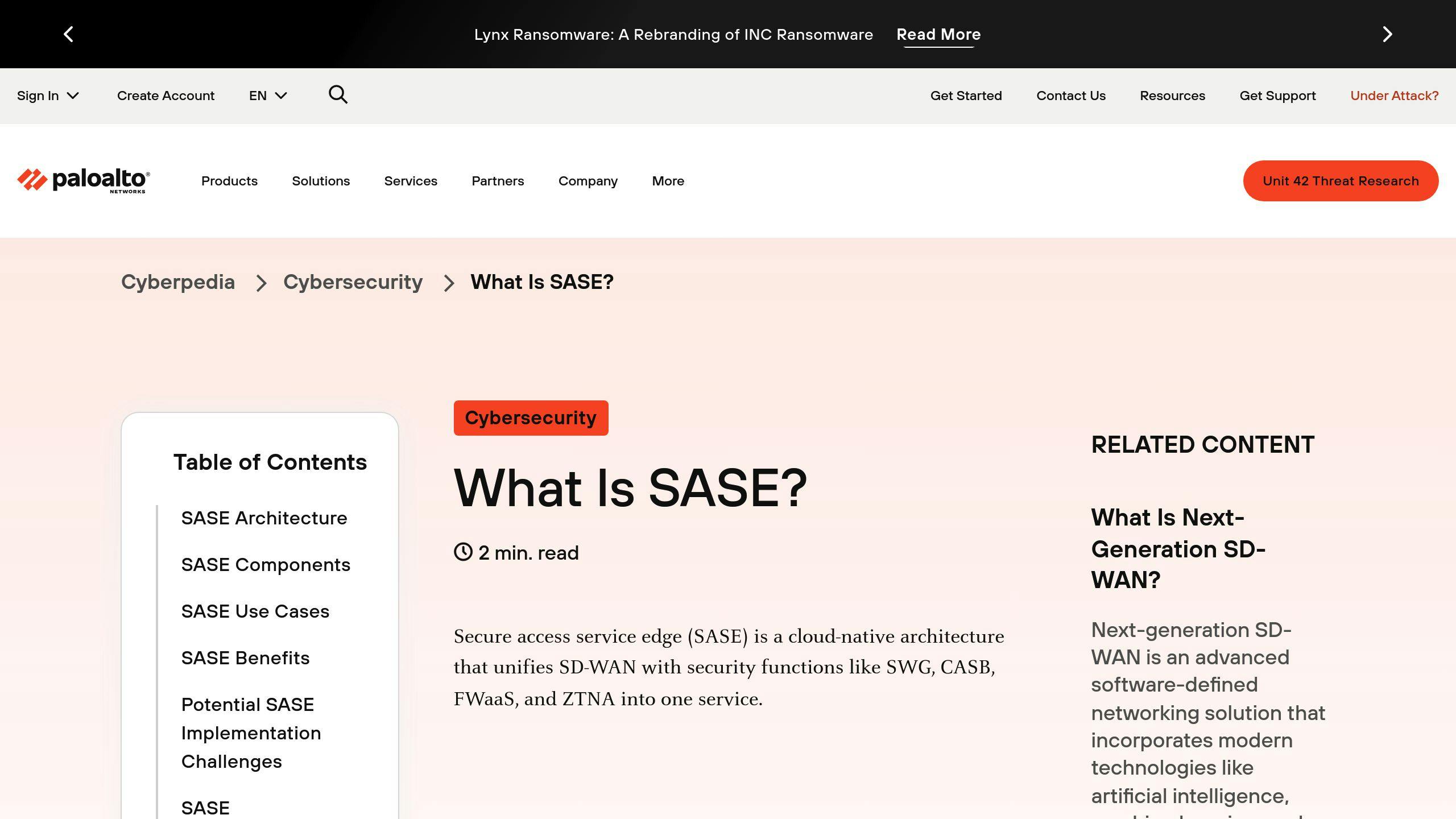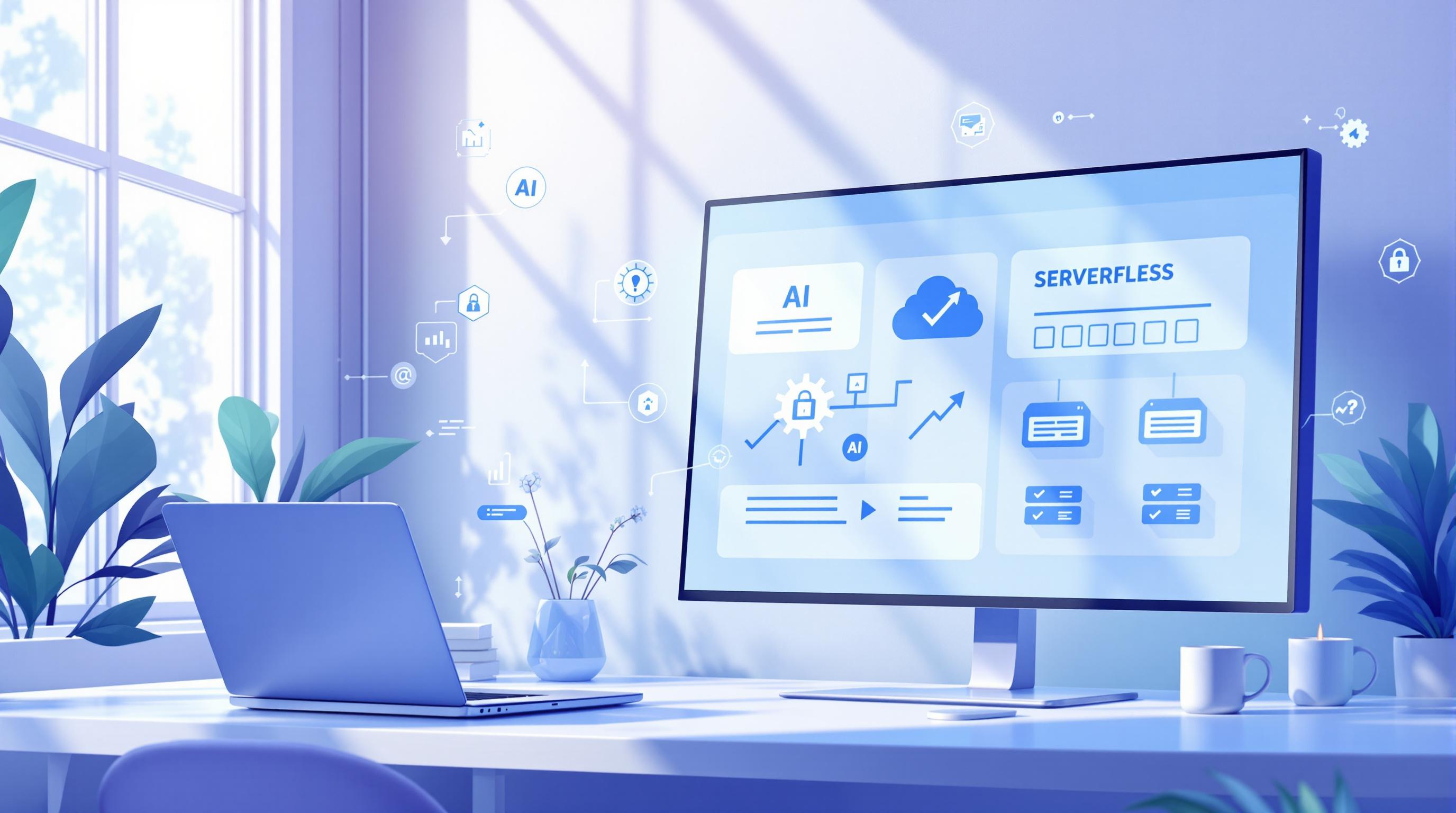Looking to choose a SASE vendor? Here's what you need to know:
SASE (Secure Access Service Edge) combines network security and connectivity in one cloud-based service. It's crucial for protecting remote work and cloud apps.
When evaluating SASE vendors, focus on these 7 key factors:
- Complete security features (NGFW, SWG, CASB, DLP)
- Cloud-native architecture
- Zero Trust Network Access (ZTNA)
- Network performance optimization
- Advanced threat defense
- User-friendly management tools
- Vendor reputation and support
Quick Comparison:
| Factor | What to Look For |
|---|---|
| Security Features | Full suite including NGFW, SWG, CASB, DLP |
| Cloud Design | Built for easy scaling and cloud performance |
| Zero Trust | Strong identity verification and access control |
| Network Speed | SD-WAN capabilities, traffic management |
| Threat Protection | Advanced detection, data protection tools |
| Management | Central policy control, network visibility |
| Vendor Support | 24/7 availability, technical expertise |
Avoid these common mistakes:
- Ignoring future growth needs
- Overlooking integration with existing systems
- Focusing only on features, not outcomes
- Neglecting vendor support quality
- Forgetting about user experience
Remember: SASE is an ongoing journey, not just a one-time purchase. Choose a vendor that can grow with your business and provide long-term support.
Related video from YouTube
What is SASE?

SASE (Secure Access Service Edge) is a cloud-based security model that combines networking and security into one service. It's built to handle the security issues that come with remote work and cloud apps.
Here's the lowdown on SASE:
It mixes SD-WAN, FWaaS, SWG, CASB, and ZTNA into one package. This combo brings some big perks:
- Keeps security tight no matter where your team works
- Speeds up your network
- Makes management a breeze
- Cuts costs
- Grows with your business
SASE moves security to the cloud, setting up checkpoints all over. This means:
- Your traffic gets checked at the nearest spot
- Access is based on who you are, not where you are
- Threats get caught and stopped in real-time
The market's booming. Gartner says it'll hit $25 billion by 2027. That's a 29% growth each year!
SASE works great for:
- Remote teams
- Multi-cloud setups
- Branch offices
- IoT devices
It's changing how we think about network security. Instead of building walls, SASE creates a secure bubble around each user, no matter where they are.
7 Key Factors for Choosing SASE Vendors
Picking a SASE vendor? Here's what to look for:
1. Full Security and Network Features
You need a complete security toolkit. Look for:
- Next-gen firewall (NGFW)
- Secure web gateway (SWG)
- Cloud access security broker (CASB)
- Data loss prevention (DLP)
Cisco's SD-WAN, for example, offers all these.
2. Built for the Cloud
Your SASE solution should:
- Scale easily
- Adapt quickly
- Perform well in the cloud
Go for cloud-native services. They manage resources better and support growth.
3. Zero Trust Security
Zero Trust Network Access (ZTNA) is crucial. It:
- Checks user identity
- Controls access based on need
Half of top SASE vendors support ZTNA. Make sure yours does too.
4. Better Network Performance
Look for:
- SD-WAN features
- Traffic management tools
These boost your network speed and reliability.
5. Threat Defense and Data Safety
You want:
- Advanced threat detection
- Strong data protection tools
These guard against attacks and keep your data safe.
6. Easy Management and Monitoring
Choose a vendor offering:
- Central policy control
- Network info tools
This makes IT management simpler.
7. Vendor Track Record and Help
Check the vendor's:
- Market position
- Customer feedback
- Tech support quality
Good support is key for long-term success.
"Choosing a SASE vendor isn't just a transaction. It's a partnership that impacts your security and efficiency for years." - David Nelson, Product Lead, Security and Connectivity.
SASE is growing fast. Gartner predicts:
- By 2024: 30% of companies will use most SASE features from one vendor
- By 2025: Over 60% of firms will have SASE plans
When choosing, focus on how the solution fits YOUR needs. Ask about their support team and problem-handling. It's about making the right choice for your company's future.
sbb-itb-9890dba
Steps to Use These Factors
Here's how to put those SASE vendor factors to work:
1. Build a comparison chart
Make a simple table. Factors on one side, vendors on the other. Like this:
| Factor | Vendor A | Vendor B | Vendor C |
|---|---|---|---|
| Full Security Features | ✓ | ✓ | ✓ |
| Cloud-native | ✓ | ✗ | ✓ |
| Zero Trust | ✓ | ✓ | ✗ |
| Network Performance | ⭐⭐⭐ | ⭐⭐⭐⭐ | ⭐⭐ |
| Threat Defense | ✓ | ✓ | ✓ |
| Management Tools | ⭐⭐⭐⭐ | ⭐⭐⭐ | ⭐⭐ |
| Vendor Support | 24/7 | Business hours | 24/7 |
2. Get specific with vendors
Ask them pointed questions:
- "How do you handle data loss prevention?"
- "Walk me through your zero trust setup."
- "What's your average support response time?"
3. Dig into user experiences
Find case studies from companies like yours. Look at the good AND the bad.
4. Take it for a spin
Most vendors offer free trials. Use them to check:
- How easy is it to use?
- Does it play nice with your current tools?
- How does it perform on your network?
5. Prioritize what matters to you
Not all factors are created equal. Rank them based on YOUR needs.
6. Think long-term
Will this vendor grow with you? Check their roadmap against your plans.
7. Get your team involved
Bring in IT, security, and network folks. They'll spot things you might miss.
"Picking a SASE vendor isn't about ticking boxes. It's about finding a partner that fits YOUR needs and can grow with you." - David Linthicum, Chief Cloud Strategy Officer at Deloitte Consulting
Mistakes to Avoid
Picking a SASE vendor? Watch out for these common pitfalls:
Not Planning for Growth
Don't just think about today. Consider your future needs too.
A retail chain chose a SASE vendor for their 50 stores. 18 months later, they had 200 stores. Their SASE solution couldn't keep up. The result? Slow connections, security gaps, and a costly switch to a new vendor.
To avoid this:
- Look at your 3-5 year growth plans
- Ask vendors about scalability
- Check if expansion needs major changes
Ignoring Integration with Current Systems
SASE needs to play nice with your existing tools.
A manufacturing firm picked a SASE vendor without checking how it would work with their custom ERP. They faced months of downtime trying to make the systems work together.
Before you choose:
- List your critical systems
- Ask about specific integrations
- Test with your key apps
Focusing Only on Features
More features doesn't always mean better.
| Approach | Pros | Cons |
|---|---|---|
| Feature-focused | Many tools | Can be complex |
| Outcome-focused | Matches business goals | Might miss niche features |
Think about your end goals. What are you trying to achieve with SASE?
Overlooking Support and Expertise
SASE is tricky. You'll probably need help.
A healthcare provider chose a vendor with great features but poor support. When issues came up during setup, they couldn't get help fast enough. This led to security and compliance risks.
Before you sign up:
- Check support hours and response times
- Ask about support staff expertise
- Consider managed services if your team lacks SASE experience
Neglecting User Experience
If SASE is hard to use, people might try to bypass it.
A tech startup's new SASE solution had complex logins. Annoyed employees started using personal devices and unsecured networks to avoid the hassle.
To prevent this:
- Include end-users in testing
- Run pilots with different user groups
- Look for user-friendly interfaces and mobile apps
Wrap-up
Picking the right SASE vendor is crucial. Here's what to focus on:
1. Full feature set
Look for vendors offering a complete package: SD-WAN, firewall, secure web gateway, and zero trust network access.
2. Cloud-native architecture
Choose solutions built for the cloud. They're easier to deploy and manage.
Prioritize vendors with robust zero trust capabilities to protect your data and users.
4. Performance
Pick a vendor that boosts network performance, especially for remote work.
5. Solid threat defense
Look for top-notch security features to guard against evolving threats.
6. User-friendly management
Go for solutions with intuitive interfaces and good monitoring tools.
7. Vendor reputation
Consider the vendor's track record and support quality.
SASE isn't just a product—it's a journey. As Chris Alberding from Windstream Enterprise says:
"Whatever your reason may be for adopting SASE, our solution is ready to address it."
When evaluating vendors:
- Read customer reviews and case studies
- Ask for demos and trials
- Check analyst reports
- Consider working with a Managed Service Provider
Don't make these mistakes:
- Focusing on features without considering your needs
- Ignoring integration with current systems
- Forgetting about scalability for future growth
FAQs
How to choose a SASE vendor?
Picking a SASE vendor? Here's what to focus on:
1. Know your needs
Look at your company size, IT skills, and current setup.
2. Security features
Make sure they offer:
- Next-gen firewall (NGFW)
- Secure web gateway (SWG)
- Zero Trust Network Access (ZTNA)
- Data Loss Prevention (DLP)
3. Network performance
Can they boost your network speed, especially for remote workers?
4. Room to grow
Pick a solution that can scale with your business.
5. Easy setup
Go for cloud-native options. They're simpler to get running.
6. User-friendly tools
Look for easy-to-use interfaces and solid monitoring features.
7. Customer support
Choose vendors known for great service and tech help.
8. Plays well with others
Make sure it works with your current systems.
9. Price
Compare costs. Does it fit your budget?
10. Follows the rules
Check that they meet industry standards and regulations.



